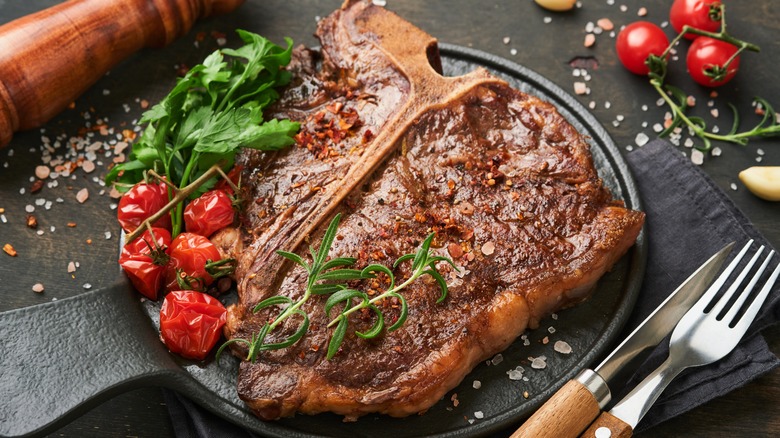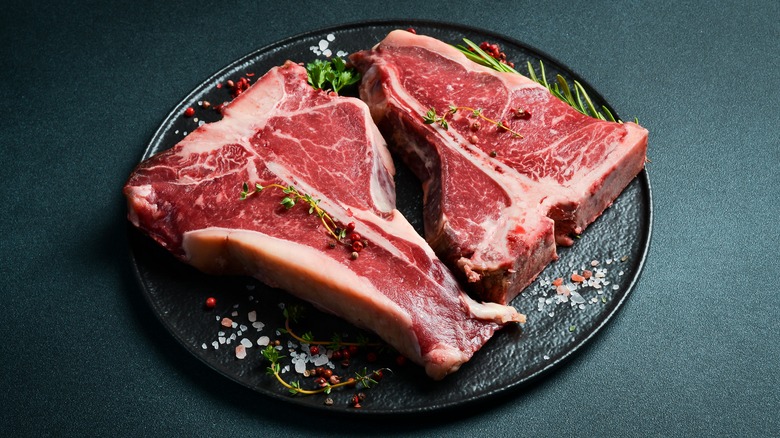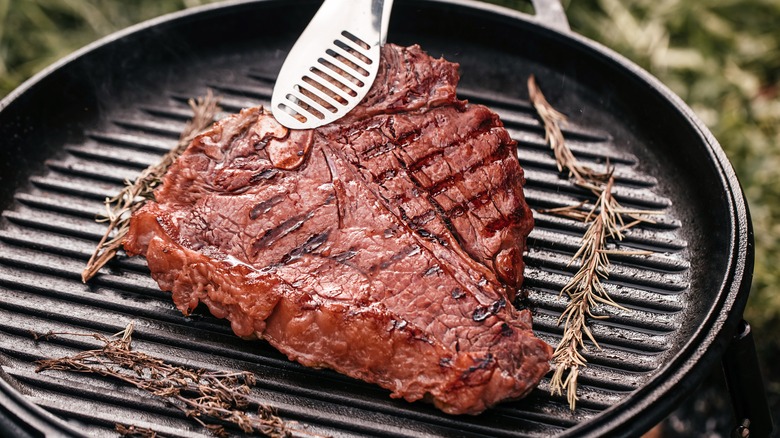Are T-Bone And Porterhouse Steaks The Same Thing?
Whether you're perusing the menu at a steakhouse or trying to choose the perfect steak at the store, you might narrow down your choices to T-bone and porterhouse — two impressively big, boldly-flavored, and visually appealing pieces of beef which offer the ultimate treat for red meat lovers. But aren't they basically the same thing? Well, no. They're actually two distinct cuts, though they share many similarities.
The reason why T-bone and porterhouse steaks look so similar is the shape. Cut from the short loin section of the animal, they both consist of two pieces of meat separated by a T-shaped bone — the thoracic vertebrae. On one side of the bone is a strip steak, and on the other side is tenderloin, which is where filet mignon comes from. Essentially, you're getting two steaks in one, whichever you go for.
The key difference between the two pieces of meat comes down to size. A porterhouse is larger, and can weigh in at around 24 ounces. It also has a bigger portion of lean tenderloin compared to T-bone. It's why porterhouse steaks often cost more than T-bones, and are sometimes referred to as the king of steaks.
The tenderloin section must be bigger on a porterhouse
All porterhouse steaks are T-bones, but all T-bones cannot be considered porterhouses. According to the USDA, on a porterhouse, the width of the tenderloin section must measure at least 1¼ inches across from the bone to the edge; for a T-bone, it only needs to measure ½ inch. So if it's 1¼ inches or over, it's officially a porterhouse.
This difference in size is not simply because one piece of meat is cut bigger than the other. Rather, it's because of where the two steaks are cut from. While they are both part of the short loin, T-bones come from the tapered front portion of the short loin, whereas porterhouses are cut from farther back. The muscle gets wider as it runs from the front to the back of the animal, which is why the porterhouse is a heftier piece of meat. Porterhouses are generally cut thicker, too, making for an even bigger steak that's ideal for sharing.
Both steaks offer the flavorsome strip cut and tender, buttery soft tenderloin. And though bone-in steaks aren't actually more flavorful than boneless, both T-bones and porterhouses are especially appetizing thanks to their best-of-both-worlds appeal. Which you choose comes down to how hungry you are, whether you want to share or prefer an individual steak, and how much you want to spend.
How to cook T-Bone and porterhouse steaks
Different cuts of steak require different cooking methods, and cooking a piece of meat that features two separate cuts can be a challenge. It's tricky to get an even finish, since the lean tenderloin section cooks faster than the more marbled strip part, especially if the loin is on the small side. The meat nearest to the bone can also wind up more rare than the outer areas.
A few tips can help you get the best results. With T-bones and porterhouses, this starts with salting the steaks generously at least 40 minutes in advance, and patting them dry so you get a better crust as they cook. You can cook a T-bone using various methods, including a cast iron skillet on the stove, on the grill, or in the oven. Just bear in mind that a thinner cut will cook more quickly, so keep a close eye on it, and use a meat thermometer to check when it's cooked to your liking.
With porterhouse, it's best to choose a thick steak for a better chance of even cooking — go for around two inches if possible. If you're grilling it, sear it over high heat before moving it to a cooler part to continue cooking. Or try searing it in a hot skillet, and then finishing it in the oven. To serve a porterhouse, especially if you're sharing it, cut each section off the bone and then slice the meat for a steakhouse-style treat.



